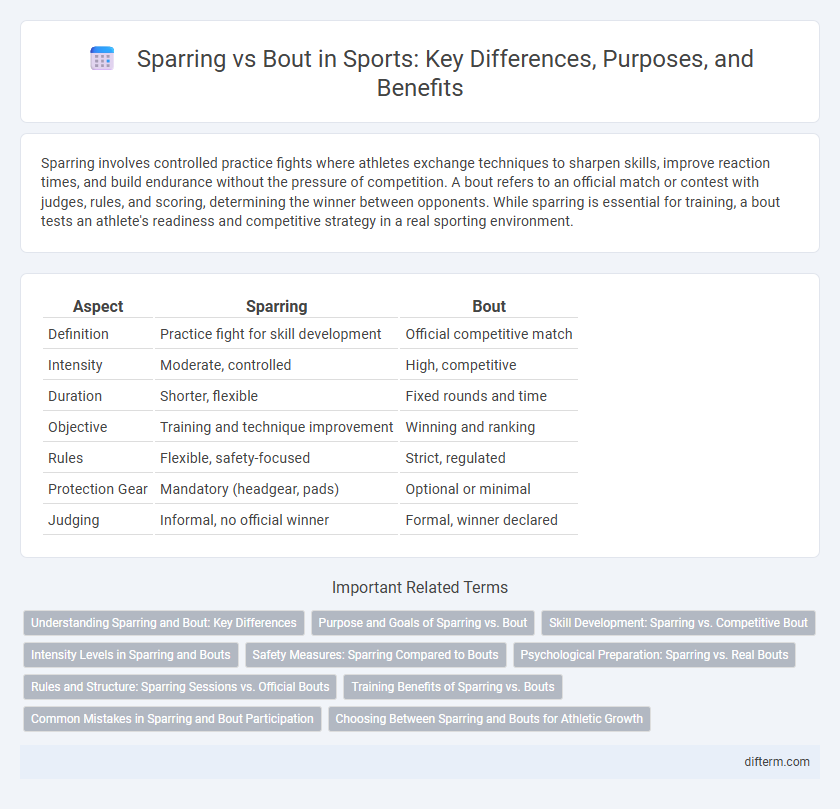Sparring involves controlled practice fights where athletes exchange techniques to sharpen skills, improve reaction times, and build endurance without the pressure of competition. A bout refers to an official match or contest with judges, rules, and scoring, determining the winner between opponents. While sparring is essential for training, a bout tests an athlete's readiness and competitive strategy in a real sporting environment.
Table of Comparison
| Aspect | Sparring | Bout |
|---|---|---|
| Definition | Practice fight for skill development | Official competitive match |
| Intensity | Moderate, controlled | High, competitive |
| Duration | Shorter, flexible | Fixed rounds and time |
| Objective | Training and technique improvement | Winning and ranking |
| Rules | Flexible, safety-focused | Strict, regulated |
| Protection Gear | Mandatory (headgear, pads) | Optional or minimal |
| Judging | Informal, no official winner | Formal, winner declared |
Understanding Sparring and Bout: Key Differences
Sparring is a controlled practice session where athletes hone techniques and improve defensive and offensive skills with reduced risk of injury, emphasizing learning rather than competition. A bout is a formal, competitive match governed by official rules and referees, where athletes demonstrate their skills to win. Understanding the distinction clarifies training purposes versus competitive objectives in sports like boxing and martial arts.
Purpose and Goals of Sparring vs. Bout
Sparring serves as a controlled practice environment where athletes refine techniques, improve timing, and develop strategies without the pressure of competition, emphasizing skill acquisition and safety. Bouts are competitive matches aiming to test and prove an athlete's abilities under regulated conditions, focusing on performance, scoring, and victory. The primary goal of sparring is learning and preparation, while bouts prioritize competition outcomes and ranking.
Skill Development: Sparring vs. Competitive Bout
Sparring allows athletes to practice techniques in a controlled environment, emphasizing skill refinement and tactical experimentation without the pressure of scoring or winning. Competitive bouts test an athlete's ability to apply skills under high-stress conditions, fostering mental toughness and strategic adaptation. Regular sparring sessions contribute significantly to muscle memory and reaction time, which are critical for success during official matches.
Intensity Levels in Sparring and Bouts
Sparring sessions typically involve controlled intensity levels to prioritize skill development and technique refinement, with participants often moderating force to avoid injury. In contrast, bouts demand peak intensity, as athletes compete under full-contact conditions to secure victory, pushing physical and mental limits. Understanding these differences in intensity is crucial for safe training progression and optimal performance during competitive events.
Safety Measures: Sparring Compared to Bouts
Sparring emphasizes controlled environments with protective gear such as headgear, mouthguards, and padded gloves to minimize injury risks. Bout competitions implement stricter rules and medical supervision, yet the intensity and competitiveness increase the chance of concussions and fractures. Training protocols in sparring focus on technique and safety, while bouts prioritize performance and strategy under regulated conditions to ensure athlete safety.
Psychological Preparation: Sparring vs. Real Bouts
Sparring sessions serve as critical psychological training, allowing athletes to simulate fight scenarios in a controlled environment that reduces stress and builds confidence. Real bouts, however, introduce unpredictability and heightened pressure, requiring fighters to manage adrenaline, anxiety, and crowd influence effectively. Developing mental resilience through sparring enhances focus and emotional regulation during actual competitive matches.
Rules and Structure: Sparring Sessions vs. Official Bouts
Sparring sessions prioritize skill development and technique refinement, with flexible rules allowing controlled contact and regular breaks, ensuring safety and learning focus. Official bouts follow strict regulatory guidelines set by sports commissions, including timed rounds, mandatory protective gear, and point-based scoring systems, emphasizing competition and fair play. The structured environment and rule enforcement distinguish official bouts from the more adaptive and educational nature of sparring.
Training Benefits of Sparring vs. Bouts
Sparring offers controlled, repetitive practice that enhances technique, timing, and defensive skills crucial for athletic development in combat sports. Bouts provide real-time experience under competitive pressure, improving mental toughness, strategy execution, and adaptability in unpredictable scenarios. Together, sparring builds foundational skills while bouts test and refine performance in authentic match conditions.
Common Mistakes in Sparring and Bout Participation
Common mistakes in sparring include underestimating controlled intensity and neglecting proper protective gear, which can lead to injuries and hinder skill development. In bout participation, errors often involve poor pacing and failure to adapt strategy mid-match, resulting in avoidable losses. Both sparring and bouts require disciplined training and mental focus to maximize performance and safety.
Choosing Between Sparring and Bouts for Athletic Growth
Sparring provides controlled practice focused on technique refinement, allowing athletes to develop skills with reduced injury risk. Bouts simulate real competition conditions, emphasizing strategic adaptability and mental toughness under pressure. Balancing sparring and bouts ensures comprehensive athletic growth by combining skill development with competitive experience.
sparring vs bout Infographic

 difterm.com
difterm.com